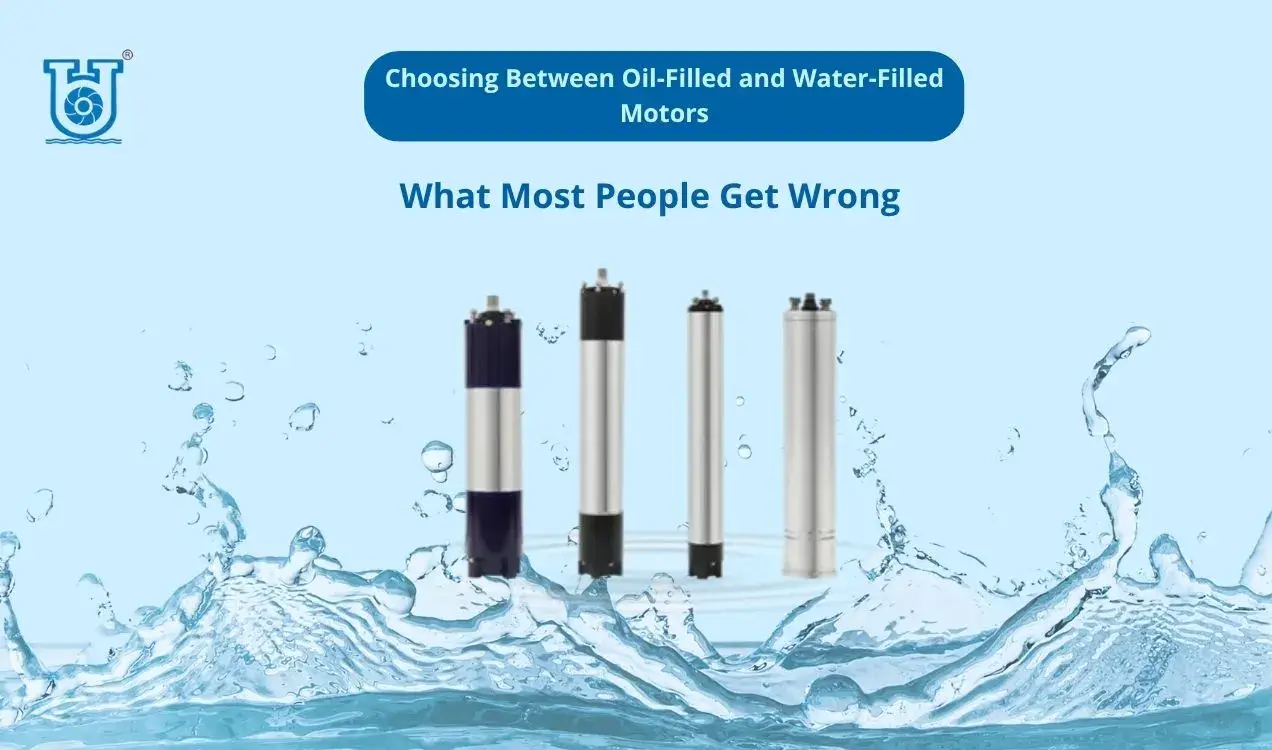Selecting the right submersible motor for your pump can feel complex, especially when faced with technical jargon and conflicting opinions. However, by focusing on key performance factors—reliability, efficiency, sustainability, and suitability for your specific application—the decision becomes much clearer.
Among the most common motor types used in submerged applications are oil-filled and water-filled motors. Each has distinct advantages and limitations, and the choice between them depends on your operational goals, well depth, environmental sensitivity, and long-term maintenance plans.
Let’s break down the real differences, dispel common myths, and help you make a well-informed decision.
Understanding the Two Motor Types
Water-Filled Motors
Water-filled motors are designed with clean, demineralized water inside the motor chamber. The water acts as both a coolant and a lubricant, particularly for bush-type bearings. These motors are widely used in residential wells, light irrigation, and shallow commercial installations.
Due to water’s high thermal conductivity, these motors typically handle heat dissipation more effectively, especially under prolonged usage. However, the water offers limited lubrication compared to oil, which can influence wear over time.
Oil-Filled Motors
Oil-filled motors are filled with a special dielectric oil that cools and lubricates internal components. The oil minimizes friction, protects against rust, and reduces mechanical wear. These motors are common in agricultural, industrial, and deep-well pumping applications.
While oil doesn’t conduct heat as efficiently as water, it offers superior lubrication, which can increase motor life in demanding environments. However, oil adds some internal drag, slightly impacting energy efficiency.
Key Differences at a Glance
| Features | Water-Filled Motors | Oil-Filled Motors |
|---|---|---|
| Cooling Efficiency | Excellent (high heat dissipation due to water’s thermal conductivity) | Good, but less effective than water |
| Lubrication | Moderate; suitable for bush bearings | Superior; reduces wear and extends lifespan |
| Depth Suitability | Ideal for deeper wells with high pressures (>50m) | Better for medium-depth or controlled environments (<50m) |
| Energy Efficiency | More efficient due to lower internal friction | Slightly lower efficiency due to oil viscosity |
| Maintenance | Requires regular checks for rust, clogging, and water purity | Lower frequency but complex if oil leakage occurs |
| Contamination Risk | Minimal; no hazard if water leaks | Higher; oil leaks can contaminate water sources |
| Environmental Impact | Eco-friendly and safe for potable use | Risky in sensitive ecosystems if seals fail |
| Service Life | Shorter if exposed to contaminated water | Longer due to reduced internal wear |
| Cost | Lower upfront, best for light to moderate use | Higher upfront, better long-term value in tough applications |
Most Common Misconceptions—And the Truth
Myth #1: Oil-Filled Motors Are Always More Efficient
While oil-filled motors are excellent under heavy-duty and long-running scenarios, they’re not always more efficient. In fact, water-filled motors often provide higher energy efficiency, especially for residential or intermittent-use applications, due to lower internal resistance.
Myth #2: Oil-Filled Motors Are More Environmentally Friendly
Oil-filled motors require proper sealing to prevent oil leaks. If leakage occurs, it can pollute drinking water or harm aquatic ecosystems. In contrast, water-filled motors, when filled with clean demineralized water, pose no such contamination risks, making them safer for potable water wells or ecologically sensitive areas.
Myth #3: Water-Filled Motors Don’t Need Maintenance
Water-filled motors are often perceived as low-maintenance. However, they require frequent inspections to check for corrosion, clogging, and water quality. In impure environments, this maintenance burden can increase. Oil-filled motors need less routine maintenance, though oil ingress or sealing issues can be more complex to fix when they occur.
Myth #4: Any Motor Works at Any Depth
Choosing the wrong motor for your well depth is a common mistake. Water-filled motors are generally more reliable in deeper wells, where heat builds up rapidly and pressure is high. Oil-filled motors can struggle in such environments due to thermal limitations.
For shallow or moderately deep wells, especially with moderate horsepower demands, oil-filled motors perform well and may offer better longevity thanks to their lubrication benefits.
Myth #5: Ignoring Installation Conditions is Okay
Installation factors like water chemistry, sand or salt exposure, and temperature fluctuations dramatically affect motor life. Oil-filled motors resist corrosion better and are often more robust in harsh water conditions, whereas water-filled motors are suitable for clean-water environments with fewer contaminants.
Which One Should You Choose?
Choose Water-Filled Motors If:
- You need an eco-friendly solution for drinking water or protected zones
- Your application involves deep wells (>50m)
- You prefer higher energy efficiency and can manage routine maintenance
Choose Oil-Filled Motors If:
- Your system operates in medium-depth or contaminant-rich environments
- You prioritize longevity and low friction wear
- You want lower maintenance frequency, with more robust protection against corrosion
Final Thoughts
Choosing between oil-filled and water-filled motors isn’t just about price or single-point performance. It’s about aligning the motor’s characteristics with real-world conditions, including:
- Application depth
- Environmental risk
- Desired lifespan
- Energy usage
- Maintenance capacity
Don’t let common myths drive your decision. Instead, evaluate technical requirements and site-specific constraints before committing to a motor type. When selected correctly, your motor will provide efficient, long-term performance maximizing both reliability and return on investment.


